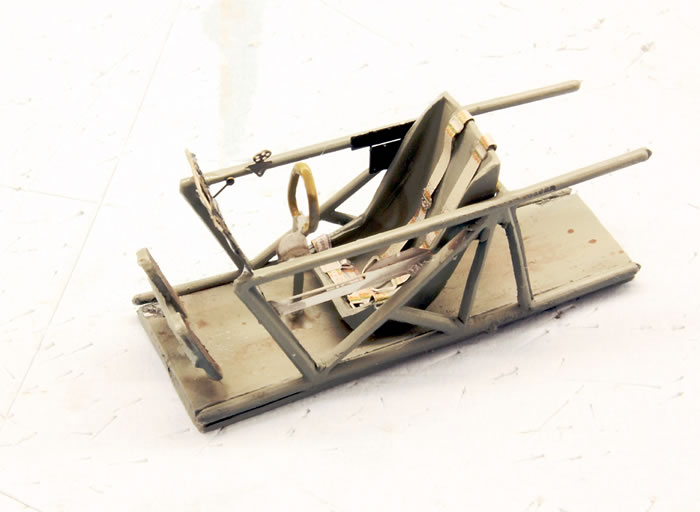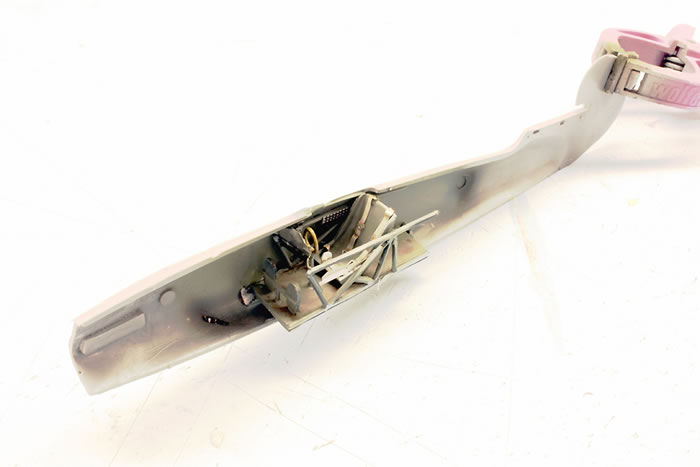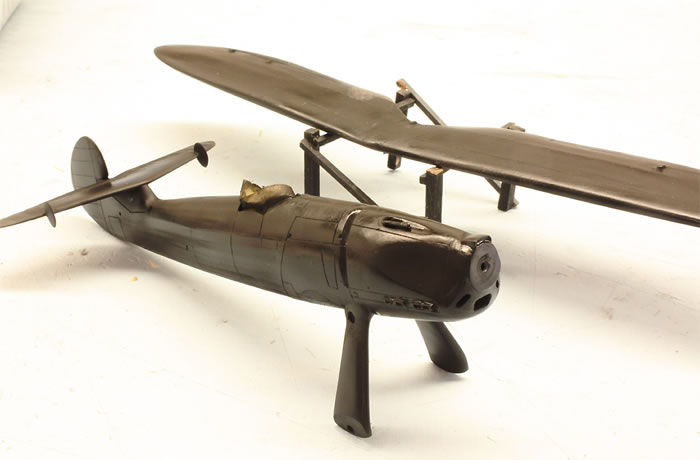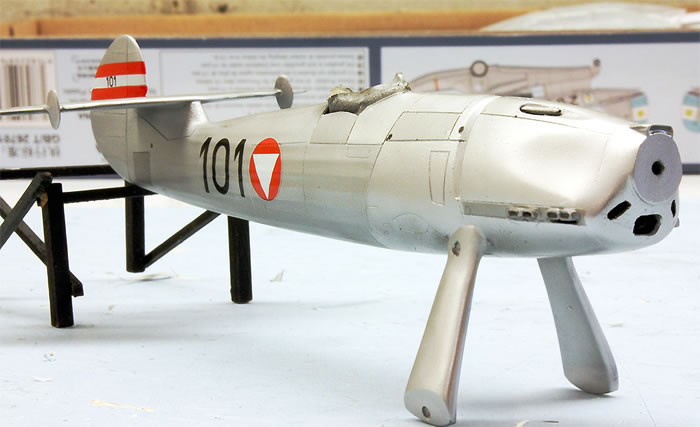Plastic Planet Club 1/48 scale
Austrian Focke-Wulf Fw 56 Stösser
by Roland Sachsenhofer

In the Austrian military aviation of the First Republic, fighter planes from the stocks of the then fascist Italy dominated by far. Among all the "Fiats", "Capronis" and "Romeo-Imans", the names of aircraft from neighbouring - but certainly not always friendly - Germany literally shine out. According to a quick count as of 1937, of the 26 or so aircraft types used by the Austrian army, 19 were of Italian origin, the De Havilland D.H. 60 came from Great Britain and only a whole 6 designs came from Nazi Germany.
One of these German designs was the elegant Fw-56 "Stößer", which was produced for the German Luftwaffe as a standard fighter trainer from the spring of 1935. In Austria, the model was used by Fighter Squadrons 1, 2 and 3 of Fliegerregiment 1, based in Vienna-Aspern. They were used in their traditional role as advanced trainers.

The first flight of the Fw-56, designed by the team of Kurt Tank and Rudolf Blaser, took place in November 1933. After extensive development, the "Stößer" was able to win a comparison flight held in May 1935 against competitors such as the Arado 76 or the He-74 so clearly that the large order for series production was placed with Focke-Wulf. By the end of 1936, some 514 models of the "Stößer" had been produced in Bremen.
The fuselage construction of the strutted high-wing aircraft consisted of a fabric-covered framework made of tubular steel, the front fuselage sector was planked with metal. The wing also showed mixed construction: large parts were made of plywood, only the trailing edge was fabric-covered.
An overview of the flight performance is also interesting: the widely used 200 hp Argus As10 accelerated the agile aircraft to a maximum of 278 Km/h; the range is given as 400 Km and the service ceiling as 6200 metres. The relatively small dimensions of 10.50 metres wingspan and 7.70 metres length are matched by an empty weight of just under 700kg, and even the maximum take-off weight of 995kg is less than a tonne. Last but not least: the name "Stößer" refers to a bird of prey that many may know better as "Sperber". This is in line with the company's policy of giving Focke-Wulf aircraft suitable bird names, which incidentally also helped the Fw-190 to get the name "Strangler", an alternative name for a bird species also known as the nine-toed shrike, which seems strange to some ears.
Throughout the war years, the slender high-wing aircraft was used as a fighter trainer, and at the end of the war, the last models were burned up in what tended to be suicidal "Störangriffe". Today, no model of this characterful aircraft has survived.
The largest export customer for the "Stößer" was Hungary with 28 aircraft, but Austria was already in second place with nine models purchased. At the beginning of the 1930s, this country was caught between two rival right-wing dictatorships. Mussolini's fascist Italy tried in these years to build up and position the Republic of Austria as a buffer state against the feared Germany, which had become a National Socialist dictatorship since 1933.
This meant, on the one hand, the generous supply of military equipment and technology - which explains the surplus of Italian aircraft described at the beginning of this article - and, on the other hand, Mussolini also promoted and demanded the establishment of fascist structures in Austrian society and politics. Nazi Germany, on the other hand, built up pressure against the "federal state of Austria", which culminated in a violent coup attempt by the National Socialists in July 1934 and the assassination of Chancellor Dollfuss, who himself ruled in an authoritarian manner. With the support of fascist Italy, however, Austria continued to resist Germany's annexation attempts for the time being.
The fate of the Republic, wedged between two right-wing dictatorships, was to be decided only when Italy, as a result of the invasion of the Empire of Ethiopia and the war crimes for which it was responsible, fell into complete international isolation and ostracism. Mussolini found a new - his only - ally in Nazi Germany, a pact that was sealed with the propagation of the so-called "Berlin-Rome axis" in 1936. The price for this new friendship, however, was Austria's independence: Mussolini dropped Austria by return of post and advised the government in Vienna to come to an agreement with Hitler quickly. Thus it took only two more oppressive years until Nazi Germany had annexed the "Alpine Republic" in March 38.
Against this background, the Fw-56 "Stößer" in the colours of the Bundesheer became a portent of shifting power constellations that would soon lead to the extinction of an independent Austria.
As a small postscript: the Austrian national emblems shown here on the Fw-56, which by international standards have remarkably independent forms, date back to these years. In 1935, flight engineer Paul Rosner, who was stationed in Graz Thalerhof, won a competition with this design; unchanged, this emblem is still used today as the emblem of the Austrian Armed Forces.
I have already written in more detail about the light and dark sides of this kit in the first article on the Fw-56 by "Plastic Planet Club". As a plus point I would like to mention, besides the fact that with these moulds it is possible to build a "Stößer" in 1/48th scale, the basic sense of the component layout.

Unfortunately, other kit qualities cannot be judged so positively. In view of the quickly obvious fact that one is dealing with a hefty short-run offer, the lukewarm fitting accuracy of many parts is not surprising. However, with plenty of putty, lots of sandpaper and a little ingenuity, you can deal with this successfully throughout.

What made things more difficult for me personally was the fact that many parts - especially the fragile ones - were cast very carelessly. Excessive removal of massive protrusions and fish skins do not necessarily increase the enjoyment of the project in the long run. In addition, the plastic, which tends to be brittle, tends to break during this process.

Not to complain long and to get to the point: in the first Fw-56 project I still used the kit parts for the "inner" bracing of the wing, but here I decided to replace them with hollow brass tubes of suitable diameter. The result looks at least as usable as the first "Stößer", but it has considerably increased the joy of building again, brought some encouraging new experiences and reduced the effort considerably.
The Austrian national emblems are all from the leftover box, as the decals included with the kit were printed and not in the register. The markings on the tail and fuselage, however, were of good quality and could be used without problems.

As usual, I used the Alclad II colour palette for the metal and metal-coloured surfaces.



In conclusion, I may say that despite all the joy of the challenge, this will probably remain the last Fw-56 from Plastic Planet Club. I will probably only put another Fw-56 on the workbench in the form of new kit moulds. This would really be worth it, because the "Stößer" from Focke Wulf is also a beautiful and elegant bird in model form!
If you are interested in the building process, please have a look here on Scalemates:
https://www.scalemates.com/profiles/mate.php?id=10148&p=albums&album=72787
Remarks will be appreciated:
As ever, remarks will be appreciated: ro.sachsenhofer@gmx.at
Model, Images and Text Copyright ©
2021 by Roland Sachsenhofer
Page Created 29 October, 2021
Last Updated
29 October, 2021
Back to HyperScale Main Page

|
Home
| What's New | Features | Gallery | Reviews | Reference | Resource Guides | Forum |